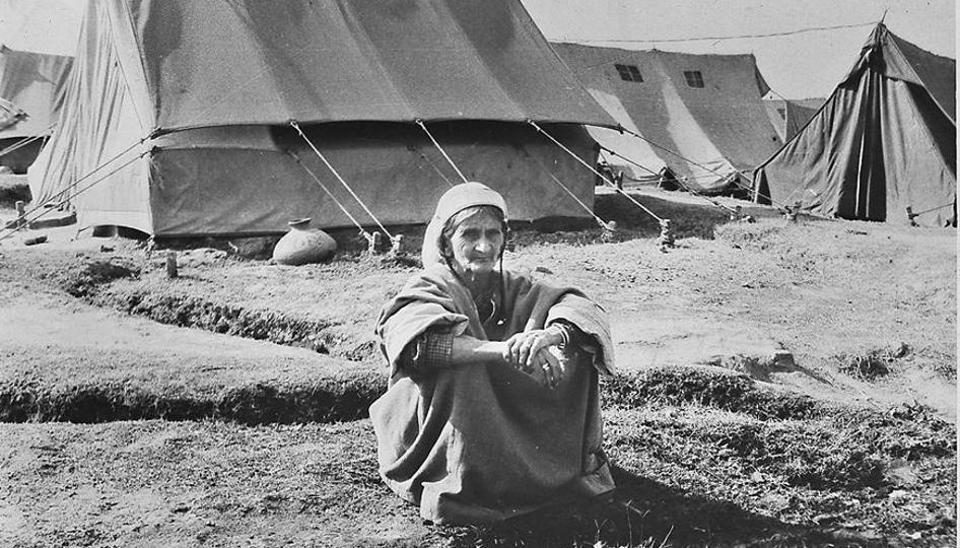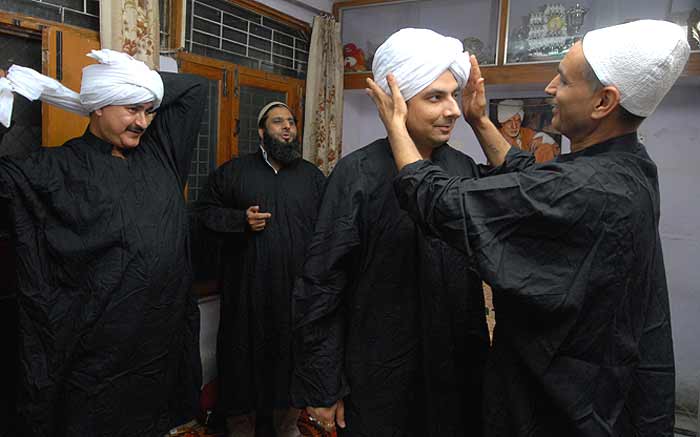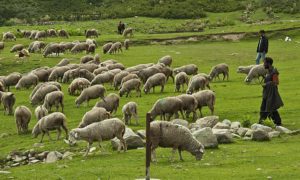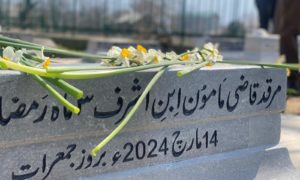Kashmir has been alienated from itself and there’s not any particular entity or community to be blamed for this.
Myriad narratives have been produced about the exodus of Kashmiri Pandits from the valley during nineties when the alleged violence against the minor community began.
One of the “national bestseller” books based on the same is “Our Moon has Blood Clots, A Memoir of a Lost Home in Kashmir” by Rahul Pandita.
Backdrop of the book is the era of late 80s and early 90s when Pandita was “forced to leave his home” as a 14-year-old boy along with his brethren due to the fear of persecution by growing insurgency in the valley.
Pandita recalls an unexceptional childhood in Kashmir “so beautiful” that even “gods were jealous of us”. He recounts his grand home in Kashmir which had “twenty two rooms”.
But things take an ugly turn overnight when his community is suddenly robbed off its existence. He recounts how the pages of his magazine with the picture of Hindu goddesses were torn and covered with snot, the pro-azaadi slogans and events that “frightened the Pandits into exile”.
The escape is fraught with tension.
Pandita writes evocatively about passing trucks filled with his scared brethren escaping to Jammu, “herded like cattle”.
The book further dwells into a tale of exile filled with severe hardships while starting a new life elsewhere.

The focus of this paper is to show how Pandita’s narrative—lacking some major elementary details—counts as a rant against Kashmiri Muslims.
The author conveniently brushes all history into black and white by demonizing the Muslim population here by producing a completely subjective view of the situation.
Pandita openly accuses the Muslim majority for jeopardizing the identity and the lives of Hindu minority. This Hindu-Muslim rift can also be studied as a strategy since it sells like hot cakes in the Indian sub-continent.
The Problematic Genre
The major impasse of the text originates with the genre. It’s a nonfiction book, a Memoir. Pandita in an interview disclosed that he wanted to bring out the book as fiction but it was only after his editor implied that it was put out as a nonfiction book.
This provokes a supposition that why would Pandita want to fictionalize such a reliable and sensitive part of his life?
The fact that the main incidences are narrated from Pandita’s memory propels the reader to accept every word with its integrity and believe that what’s being written is the only true aspect of the story, as memory is something that cannot be doubted.
But Pandita’s remembrance sieves some considerable portion of the story of exile which will be later discussed in the paper.
He does not equip the book with references or citations for the historical events mentioned in the book. As a result a lot of what Pandita writes remains invalidated and contradictory. It evokes George Bernard Shaw’s telling remark, “All autobiographies are lies”.
Pandita’s Idea of Exile
With the title of the book “Our Moon has Blood Clots”, Pandita creates a detached identity for his community and fabricates an environment where he was alienated from his homeland.
The title somewhere proposes that since the advent it was a task for Pandits to survive in Kashmir. He writes, ‘I knew I was in a permanent exile’ (Pandita, 7). But truth is just the opposite.
Due to the armed conflict in the valley, the place became insecure for all the communities that lived here. Several Muslims migrated to Pakistan and settled in refugee camps there. A vast number of Sikhs also left Kashmir and settled in different parts of India and along with that Pandits also left.
And it did not particularly begin in 1990.
People were departing before that as well. Many Pandits even said that they were leaving Kashmir to “preserve their personal interest and for a better future” (Azad, 2).
But Pandita uses only epoch of 1989-1990 to formulate a sense of collective victimhood among the readers.
Eventually, Kashmiri Pandit and Muslim community started blaming each other for their miseries. It was not only one end that suffered, but both the communities suffered in variable ways.
On one hand where the Pandit community left in huge numbers but they were also accepted with open arms in different parts of India whereas the possibility was not same with Kashmiri Muslims. They had to face contentious environment everywhere in India.
And hence, Pandita’s discourse, where he blames Muslim community for their sufferings, solely increases the alienation between the two communities (Maqbool, 101).
His idea of permanent exile thrusts forth a thought that Pandits may never be able to return to Kashmir.

A Kashmiri Pandit woman at a refugee camp in Jammu.
The author describes the actual night of exile with a lot of details — the night of January 19, 1990.
Pandita recalls that there began announcements in every mosque to tell Pandits to leave Kashmir.
He details the fear triggered by the continuous chanting of slogans on the mosque speakers. He expresses his extreme anger against the Muslim population who did not come to help them as they were being “threatened” and their houses were “being looted and destroyed”.
This in verity did not only create fear among the Pandit but among the Muslim population as well, as they were unaware of the happenings too (Ahmed, 105).
Despite of the danger looming over their lives, huge number of Muslims came out together to protect the lives and properties of their Pandit friends and neighbours.
But this fact didn’t appear in Pandita’s book as it doesn’t suit his narrative. Moreover, there’re no recorded or written media reports about the same incident. (Ahmed, 232).
However, Wajahat Habibullah, a former bureaucrat who served Kashmir in the 1990s said that it was discovered by the government after investigation that the slogans from the mosque were not raised by the people, but the tapes were being played on loudspeakers (Maqbool, 105).
Moreover, Pandita’s accusation remains under serious skepticism that an entire population abruptly one night came out their houses with the same motive.
Such a big event happening without a gigantic communication and synchronization seems like a ruse and part of a bigger unknown plan.
Pandita claims that the environment was “well-orchestrated” without any solid proof to the statement but crassly rejects the interference of then Governor of Jammu and Kashmir, Jagmohan or any government entity in the exodus.
The author does not provide any further justification to this statement. He even goes on defending Jagmohan by saying that he was not even in Kashmir when the event happened.
But it’s said that majority of the Pandits were told to migrate overnight so that massive crackdowns would be carried on the Muslims without any collateral damage to the minority (Ahmed, 265).
According to one migrated Pandit, K.L Koul, “Pandits were told that the government had plans to kill about 1 lac Kashmiri Muslims in order to overcome the uprising against India” (Ahmed, 239).
The government’s interference in the event is impending and Pandita marks it imperceptible because there’s no clear reason why so many people left on that night.
Pandita’s half-truths
One of the major mechanisms Pandita uses throughout the book is the idea of half-truth and not providing complete information about many occurrences he talks about.
He conveniently leaves out the happenings from 1947-1990 but craftily handpicks episodes from the history that victimize him and also increases the intensity of the incidences against Pandits in Kashmir.
He talks about the much-written about case of Parmeshwari Handoo (Pandita, 23) in 3-4 lines—procuring no context to the story and not even what came next.
Handoo was a consensual adult who married her Muslim co-worker in 1967 and reverted to Islam according to her own will. But this thing did not sit well with the Pandit community. They reacted sharply to this as they believed that Muslims wanted to convert all the Hindus. Agitations intensified, they boycotted all schools, colleges and offices, and wanted Handoo to be presented before the police (Ahmed, 179).
Pandita desperately looks out for incidences or moulds them in a certain way where every violent happening is started by Muslims.
When he talks about the 1986 Anantnag riots where the Pandit houses were ravaged, he fails to mention its trigger — the communal violence against the Muslims in Jammu.
Pandita weaves a notion that there was a peak communal violence against the Pandits and the minority was fighting for their survival.
He conveniently over-amplifies the sufferings his community had to face but plays deaf and dumb to all the ghastliness Muslims of the valley have been facing since ages despite being the majority.
His book lacks a broader and the overall widespread picture of how the incidents took place.
There’s no comment on the viciousness against Muslims in the book, the sense of alienation they have been going through and how unfairly they have been treated in every sphere of life as far as one can remember.
It can be perceived throughout the book that the author is just undoing the bitterness that he feels for his rival community.

Kashmiri Muslims and Pandits. [Photo: Tribhuvan Tiwari]
Pandita has even distorted and misreported the figures. He has tremendously magnified the number of Pandits who migrated and who were killed. He mentions at least 350,000 Pandits left Kashmir but this number does not fit in with the 1981 census report.
Media reports such as India Today and Asia Watch carry figures that less than 100,000 people left Kashmir.
Number of killings have been projected to be 2000-3000 whereas the actual number lies somewhere around 200 (Ahmed, 251).
This indeed does not imply that the number was less, so it loses its significance, but it creates an image of Kashmiri people as some blood hounds which is completely untrue.
Without a doubt Kashmiri Pandits lost their homes in Kashmir but blaming a whole lifelong population for that does not seem justified.
Kashmir has witnessed episodes like exiles and exoduses since its existence and the exodus of 1990 was a one of the many.
The valley has been alienated from itself and there is not any particular entity or community to be blamed for this.
A resident of Srinagar, Toiba Paul is a student of English language and literature. She has written a literary academic paper under the title “Women and War; Poetic Escape of the Doubly Marginalized” and published book review under the title “Reading The Book Thief in Kashmir”.
BIBLOGRAPHY
- Ahmed, Khalid Bashir. Kashmir Exposing the Myth behind the Narrative. Sage publications, 2017, pp 105, 179, 232, 239, 251, 265.
- Bhasin, Anuradha. ‘A Moon has Many Shades’. Economic & Political weekly, Vol. 48, issue no. 17, 2013.
- Essa Azad. ‘Kashmiri Pandits: Why We Never Fled Kashmir’. Al-jazeera, 2011.
- Maqbool, Tajamul. ‘Narrating the Pandit Exodus’, Research Gate, December 2020, pp 105.
- Pandita Rahul. Our Moon has Blood Clots; a Memoir of a Lost Home in Kashmir. Penguin Random house, 2013.
- Reddy, Shri. G. Krishan. ‘Return of Kashmiri Pandis to Valley’. PIB Delhi, 2021.








